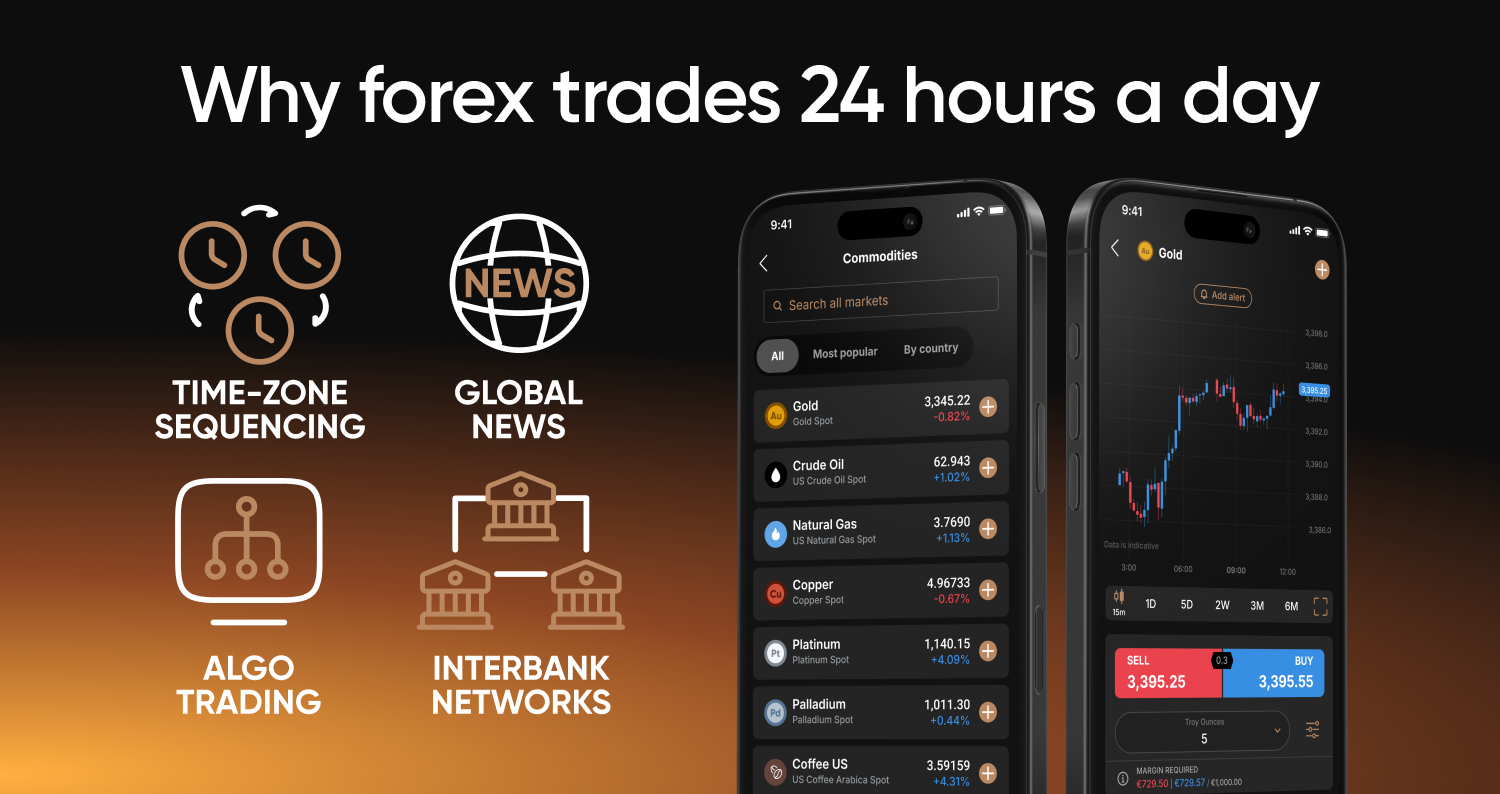Forex 24/5 trading: Market hours, key sessions, and best strategies

What is forex 24/5 trading?
Forex 24/5 trading refers to the continuous availability of the decentralised, over-the-counter (OTC) currency market from 22:00 UTC on Sunday to 22:00 UTC on Friday. This forex 24 hour trading model is enabled by the sequential opening of major financial centres – Sydney, Tokyo, London, and New York – across the globe. It allows market participants to respond immediately to economic news, geopolitical developments, and central bank decisions, without waiting for a single exchange to open.
Why forex trades 24 hours a day
The forex market operates continuously due to:
- Time-zone sequencing – as one financial centre closes, another opens, maintaining liquidity across regions.
- Interbank networks and ECNs – these decentralised systems connect major banks and electronic communication networks (ECNs), matching buy and sell orders in real time.
- Algorithmic and high-frequency trading – automated systems in each region affect bid-ask spreads, which may widen during periods of lower local activity.
- Global news cycles – economic data releases and policy announcements, from Asian trade figures to statements from the US Federal Reserve, can occur at any time, prompting market participants to remain engaged.
This is why traders often describe it as trading forex 24 or ‘forex trading 24 5’, even though liquidity pauses over weekends.

The four major trading sessions
The global forex market divides into four main sessions, each driving activity at different times of day. Our table below shows each of these sessions’ hours in UTC.
| Session | UTC hours | Primary focus |
|---|---|---|
| Sydney | 22:00-07:00 (Sunday-Friday) | AUD and NZD crosses; commodity-linked pairs. |
| Tokyo | 00:00-09:00 | USD/JPY and EUR/JPY; Japanese economic releases such as trade balance and CPI. |
| London | 07:00-16:00 | EUR/USD and GBP/USD; announcements from the ECB and BoE. |
| New York | 12:00-21:00 | USD majors; US non-farm payrolls at 12:30 UTC on the first Friday of each month. |
Learn more about global forex trading hours on our forex market hours page.
What 24-hour trading involves
Whether you call it forex 24 hour trading or 24/5 trading, continuous access requires robust routines:
- Automated alerts and Expert Advisors (EAs) – set custom notifications for key price levels and deploy EAs for round-the-clock order management. Broker support for EAs may vary outside core hours.
- Order types – use limit, stop loss, and one-cancels-other (OCO) orders to define entry and exit points.*
- Weekend gap risk – monitor the Friday 22:00 UTC close and the Sunday 22:00 UTC open for potential price gaps, and adjust positions or hedge via correlated instruments.
- Liquidity variation – liquidity in OTC markets typically thins during the Asian session (Sydney and Tokyo), which can increase slippage on larger orders.
*Stop loss orders aren’t guaranteed. Guaranteed stop loss orders (GSLOs) incur a fee if activated.
Past performance is not a reliable indicator of future results.
Best times to trade
Trading activity and liquidity vary throughout the day. Identifying the most active windows can help traders frame when conditions are potentially more volatile.
Session overlaps
- London–New York overlap (12:00-16:00 UTC): Highest volumes and narrower spreads, often suitable for breakout or trend-following strategies.
- Tokyo–London overlap (07:00-09:00 UTC): Early volatility; a period often used for range-break strategies on JPY pairs.
High-impact economic data
- Examples include US non-farm payrolls, UK CPI and RBA rate decisions
Smaller positions with defined stops may be used ahead of announcements. Full-size entries immediately before releases are typically avoided due to spread widening.
Quiet periods
- Late Sydney (04:00-07:00 UTC) and late New York (18:00-21:00 UTC): These periods usually show limited directional movement, more suited to mean-reversion or scalping within tight ranges.

24/5 forex CFD trading strategies
Traders can apply different approaches to 24/5 forex markets, using timeframes and tools that suit day, swing, trend or position trading.
- Day trading: identify the previous session’s high and low, then observe the London open (07:00 UTC) for potential breakouts. Confirmation may come from a volume indicator such as on-balance volume, trend strength from ADX, and momentum signals from RSI.
- Swing trading: during Tokyo hours (00:00-09:00 UTC), price often oscillates between defined support and resistance. Indicators such as Bollinger Bands and RSI can highlight entry points at extremes, with mean reversion as the target.
- Trend trading: focus on currency pairs with positive interest rate differentials. Positions are sometimes established during lower-volatility sessions (such as Tokyo) and held through the 21:00 UTC rollover, when daily financing adjustments occur. Monitoring central bank communications can help manage exposure to policy changes.
- Position trading: before major data releases, pending orders can be placed just outside key levels. Breakout or retracement setups are then assessed after the release, using volatility shifts, and sentiment indicators for confirmation.
Explore more approaches on our CFD trading strategies page.
Weekend forex trading: Possibilities & limitations
While the interbank FX market closes Friday 22:00 UTC, some brokers offer forex after hours trading via synthetic weekend pricing. Key considerations include:
- Wider spreads: Reduced liquidity can lead to larger bid-ask spreads.
- Slippage risk: Sharp moves may occur when trading resumes at 22:00 UTC on Sunday.
- Broker policies: Weekend margin requirements and rollover fees should be checked, as they are often higher due to increased capital costs.
Global perspective on trading hours
Trading sessions shift across regions, with daylight saving adjustments affecting UTC hours throughout the year:
| Session | Winter UTC | Summer UTC* |
|---|---|---|
| Sydney | 22:00-07:00 | 21:00-06:00 (AEDT, November - March) |
| Tokyo | 00:00-09:00 | 00:00-09:00 (no DST) |
| London | 07:00-16:00 | 06:00-15:00 (BST, March-October) |
| New York | 12:00-21:00 | 12:00-21:00 (EDT, March–November) |
*UTC hours vary according to regional daylight saving time adjustments.
Broker settings
Check whether your platform’s server time aligns with UTC to avoid discrepancies when tracking session open and close alerts. Chart timestamps and economic calendar filters may need to be adjusted accordingly.
FAQ
What hours does the forex market operate?
The forex market operates continuously from 22:00 UTC on Sunday until 22:00 UTC on Friday, reflecting the sequential opening and closing of major financial centres worldwide.
Which forex session is the most liquid?
The London session – running from 07:00 UTC to 16:00 UTC – typically shows the highest liquidity, particularly during its overlap with New York from 12:00 UTC to 16:00 UTC, when trading volume and market participation are at their peak.
Can I trade forex on weekends?
The interbank forex market closes at 22:00 UTC on Friday and reopens at 22:00 UTC on Sunday. Some brokers and OTC platforms may provide forex after hours trading, but these are synthetic and often associated with wider spreads, higher slippage risk, and different margin requirements.
What’s the best time of day to trade forex?
The most active trading window is usually during session overlaps, especially London–New York from 12:00 UTC to 16:00 UTC, when liquidity is highest and spreads are narrower. Additional activity occurs during the Tokyo–London overlap from 07:00 UTC to 09:00 UTC.
Is 24-hour forex CFD trading riskier than trading share CFDs?
Forex CFD trading carries risks that differ from share CFDs, including continuous exposure to geopolitical events, potential weekend gaps, and overnight financing costs. Effective risk management and careful position sizing are important for mitigating these risks.
Do all brokers allow trading 24/5?
Most regulated forex brokers provide 24-hour trading from Sunday evening to Friday evening (UTC). However, server times, margin rules and rollover policies differ, so it is important to check a broker’s specific trading hours and terms.
How do session overlaps affect forex trading?
Session overlaps concentrate liquidity and volatility, leading to narrower spreads and more pronounced price movements. During the London-New York and Tokyo-London overlaps, order flow is typically higher and execution speeds are faster.